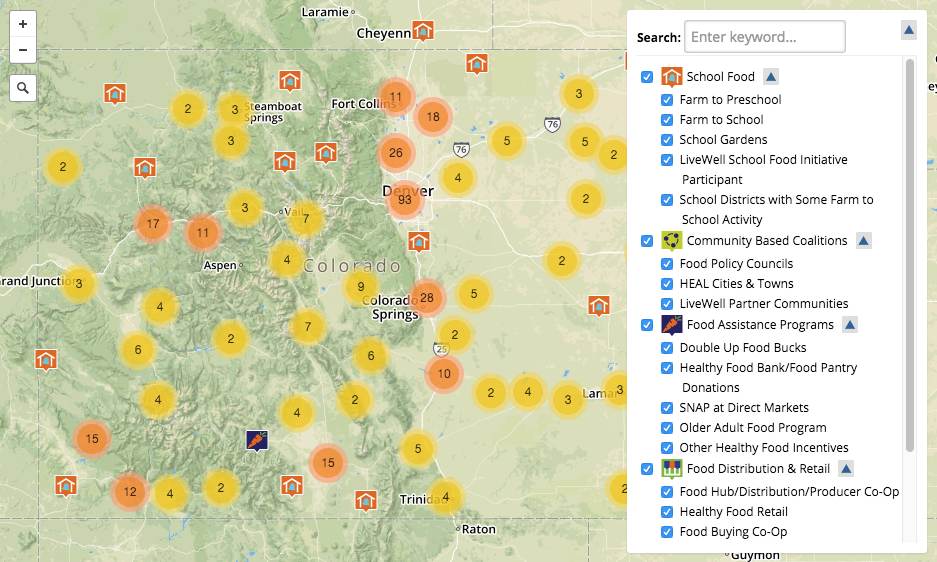Three Ways to Improve Access to Healthy Food
- Copyright
- 2017
- Published Date
- 03/15/2017
- Published By
- Community Commons
More than forty million Americans live in food insecure households – that’s 13 percent of US households, including 13 million children. Over the last decade we have seen an uptick in communities taking action to not only alleviate food insecurity, but to increase access to healthy foods. From farmers markets to mobile markets, communities are adopting strategies that are the most appropriate and effective for their residents. While it is still a learning process for many communities to determine how to serve all their residents in the most efficient way, several promising strategies are being implemented. Three popular strategies are outlined below.
Mobile Markets
Mobile markets are cropping up around the US as a strategy to increase access to healthy food, particularly in food deserts. They essentially “meet you where you’re at”, often serving areas that have poor access to super markets and grocery stores- or areas that simply lack access to healthy food options. The communities they serve tend to have residents with a lower socio economic status and are more burdened by obesity, heart disease, and diabetes.
While people who shop at mobile markets do eat significantly more fruits and vegetables than non shoppers, there are some general knowledge and logistical gaps that need to be filled in order to be more effective in the communities they serve. First, there needs to be better strategy of raising awareness of the mobile market in communities, along with convenient locations and hours of operation.
Second, customers need to be education on what a serving is, how many servings of fruits and veggies should be eaten each day, how to cook fruits and veggies, and perhaps most importantly a strategy to combat the perception that fruits and veggies are unaffordable, luxury foods. Mobile markets that accept SNAP and WIC nutrition assistance programs will have an even greater impact on access.
A great example of a mobile food market is the Hamilton County Mobile Food Market in Chattanooga, TN.

Food policy councils
Food policy councils advise state and local governments on policy to improve access to healthy, affordable food. They develop food policies and programs that directly impact individuals’ access to healthy foods. While they may not directly increase consumption of healthy foods, they are responsible for taking actions that lead to the development of community and school gardens, farm-to-institution programs, increasing enrollment in food assistance programs, and creating new forms of insurance for small, local producers. They are a great example of collaborative efforts among nutrition, health, education, agriculture, policy, and business stakeholders.
The Colorado Food Policy Network has grown to include more than 18 food policy councils around the state. Community Commons has supported their efforts to collect, visualize, and analyze state, regional, and local data. Their Colorado Food Systems Hub on Community Commons allows food policy councils to connect and collaborate so they can better coordinate efforts around the state. The Colorado Movement Map visualizes where and what kind of work each council is doing.

Farmers markets, community supported agriculture, farm-to-institution
These programs not only increase access to healthy food throughout the community, they support local producers. Right now, people are very engaged in buying local, organic foods. In fact, it’s a market that has been growing 40-60 percent each year. It’s growth that is seen in rural and urban parts of America. People trust local produce more, and want the satisfaction of supporting local producers. That’s why farmers markets, CSAs, and farm-to-institution programs are popular outlets. While farmers we are seeing a peak in farmers markets, we’re also seeing an increase in more farm-to-institution programs (i.e. schools, hospitals, restaurants, grocery stores) and food hubs. Food hubs increased 288 percent from 2007 to 2012! So we’re seeing many communities integrate local produce into schools and businesses and farmers finding more cost-effective venues to sell their products- the sign of a maturing market.
Mobile markets, food-to-institution programs and food policy councils are great ways to increase access to healthy foods and support local producers. Research on effectiveness and best practices for implementation for some of these strategies are still formative. However, the fact that we’re seeing a growth in mobile food markets and local producers expanding to more businesses and institutions is a promising sign that healthy food is becoming more accessible to America’s most vulnerable populations.
View StoryRelated Topics
